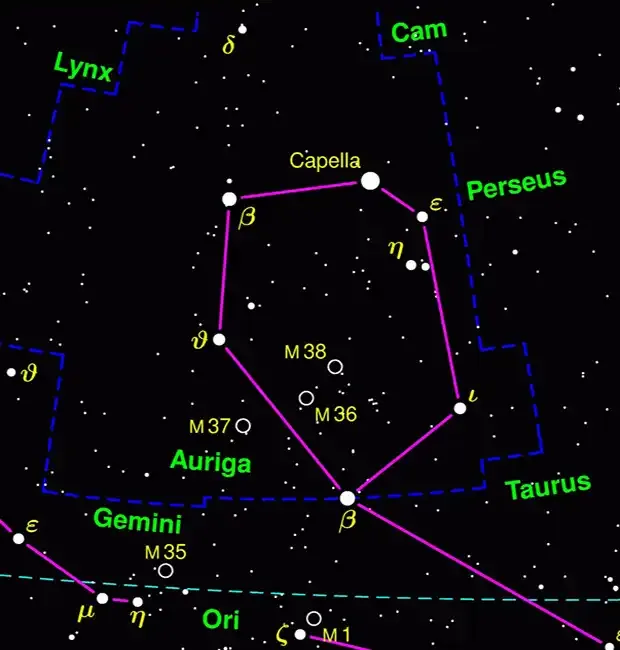
Auriga is a prominent constellation in the northern sky, often depicted as a charioteer holding the reins of a chariot. It is one of the 88 modern constellations and has been recognized since ancient times. Auriga is particularly famous for its bright stars and deep sky objects, making it a favorite among stargazers.
Auriga is bordered by several constellations, including Gemini, Taurus, Perseus, and Lynx. It is best known for its pentagon shape, which is formed by its five brightest stars. The constellation covers an area of 657 square degrees, ranking it 21st in size among the modern constellations.
Key Features
One of the most notable features of Auriga is its bright stars, particularly Capella, the sixth-brightest star in the night sky. Auriga also contains several star clusters and nebulae, making it a rich area for astronomical observation. The three open clusters known as the "Kids" are particularly noteworthy: M36, M37, and M38.
Mythology
In Greek mythology, Auriga is often associated with the charioteer Erichthonius of Athens, a mythical king who is said to have invented the four-horse chariot. The constellation is sometimes also linked to the story of the god Hephaestus, the blacksmith of the gods, who used a chariot to move around due to his lameness.
Notable Stars
- Capella: The brightest star in Auriga and the sixth-brightest in the sky, Capella is a yellow giant star about 42 light-years away from Earth.
- Menkalinan (Beta Aurigae): The second-brightest star in Auriga, Menkalinan is an eclipsing binary system located about 83 light-years from Earth.
- Mahasim (Theta Aurigae): A star located at the point of the pentagon shape, Mahasim is a white giant located around 173 light-years away.
Visibility
Auriga is best viewed in the Northern Hemisphere during the winter months, from November to April. It is visible in the northern latitudes and can be seen from most of the southern latitudes as well, although it appears lower on the horizon. Its brightest star, Capella, is often one of the first stars to appear after sunset, making Auriga relatively easy to locate.
Tips for Observing
- Use Binoculars: While Auriga's brightest stars are visible to the naked eye, binoculars or a small telescope will help you observe the star clusters and nebulae within the constellation.
- Look for the Pentagon: To locate Auriga, look for the pentagon shape formed by its five brightest stars. Capella, the brightest, is a good starting point.
- Observe in Winter: Auriga is most visible in the winter months, when it is high in the sky during the evening hours.
